
Living or visiting Georgia and wondering what bird you’re looking at? This article covers the most common birds of Georgia. Odds are high the bird you’re looking at is one of them. It will also inform you on how to identify them.
Birding in Georgia
Georgia’s coast is still relatively underdeveloped, which makes it a perfect home for birds. The state has many wildlife refuges to protect over 340 species of birds that live here or migrate through the state. Hiking trails make it convenient and a pleasure to explore Georgia’s bird population.
Harris Neck National Wildlife Refuge east of Interstate 95 is a 2,800-acre coastal refuge with saltwater marshes, freshwater ponds, maritime forests, and fields, and it’s one of Georgia’s major birding sites. More than a dozen different wading birds nest here, and Harris Neck is especially known for its Wood Stork population by Woody Pond.
The wetlands here also contain several types of Egrets, Herons, and Ibises. The trails can yield a treasure-throve of shorebirds and woodpeckers, as can the four-mile auto tour. The Painted Bunting tends to be a favorite among birders.
Jekyll Island is a seven-mile-long island along Georgia’s coast, and more than 300 of the state’s birds can be spotted here. The island used to be a ritzy getaway for Vanderbilts and Rockefellers; now, it has campgrounds and hotels for anyone wishing to explore its marshes and seabirds, gulls, waterfowls, and wading birds.
Wood Storks can be spotted here during the summer, while an entire community of wrens gathers on the island for the winter. The southern portion of the island hosts sea ducks, Northern Gannet, gulls, shorebirds, and others.
Piedmont National Wildlife Refuge is located 25 miles north of Macon and is a diverse terrain of forests, ponds, and wetlands. There are several roads for birding, including the Little Rock Wildlife Drive. Some of Piedmont’s residents include the Red-cockaded Woodpecker, the Brown-headed Nuthatch, and Bachman’s Sparrow. Birders will also find several species of warblers among the 180 species that are at home here.
Kennesaw Mountain National Battlefield Park has been designated as an Audubon Important Bird Area. While there are 18 miles of trails, the best way to go birding is to hike the 1.2-mile paved road – back and forth – until the vireos, thrushes, orioles, warblers, and tanagers hiding here have been spotted. Lucky hikers may spot 20 different kinds of warblers during the spring months.
Okefenokee National Wildlife Refuge has been called the most magnificent natural area on our entire continent – filled with swamps, prairies, and coniferous forests. The birds share the terrain with bobcats, bears, and alligators. For the best sighting of birds, a canoe outing is highly recommended.
Common Birds of Georgia
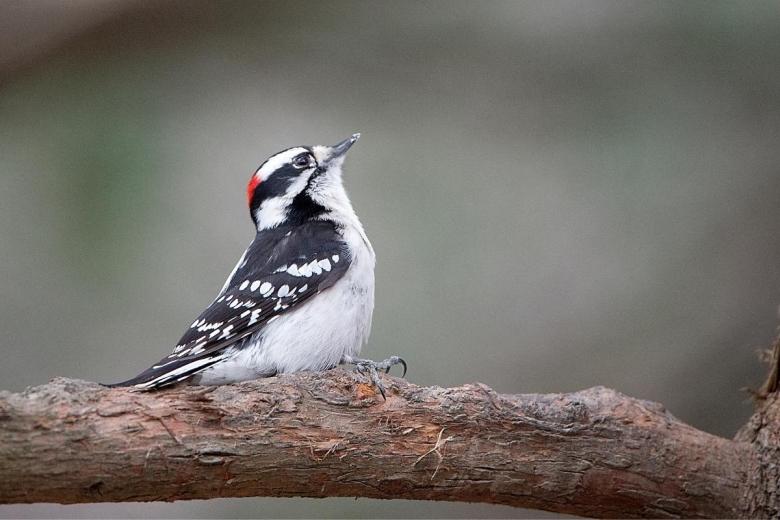
Downy Woodpecker is the smallest of the Georgian woodpeckers and resides here throughout the year. They have white underparts and black and white checkered wings. The head is white with a black cap and a black mask. The male is distinguishable by the red patch on top of the head.
They grow 5.5 to 6.7 inches in length and weigh 0.7 o 1.0 ounces with a wingspan between 9.8 to 11.8. They reside in woodlands and deciduous trees as well as parks and orchards where they feed on insects, seeds, and berries. They will visit bird feeders for suet.
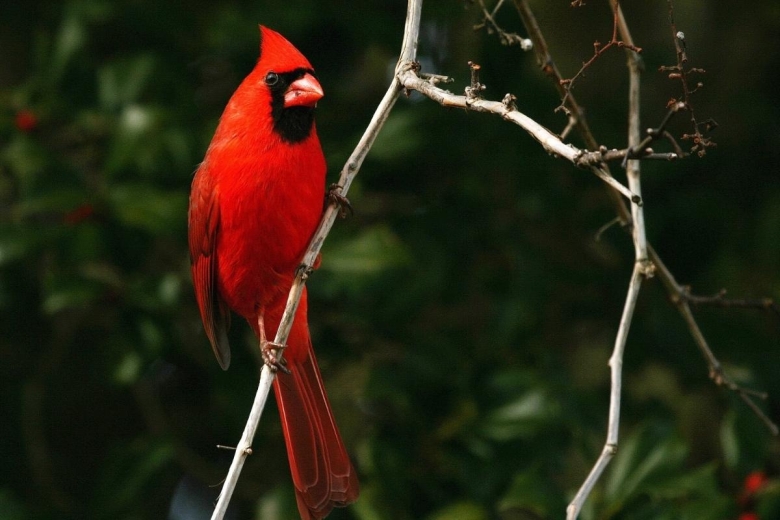
Northern Cardinal is Georgia’s state bird and the most popular bird in the state. Adult males in spring and early summer are bright yellow with a black forehead, black wings with white markings, and white patches both above and beneath the tail. The female looks entirely different, with a pale brown body with just a few hints of redness.
Both sexes grow to a length of 8.3 to 9.1 and weight 1.5 to 1.7 ounces with a wingspan between 9.8 and 12.2 inches. They inhabit backyards, shrubby areas, and parks. The Northern Cardinal feeds on insects, seeds, and berries.

American Goldfinch can be found throughout Georgia. During the spring and early summer, the male is a vivid yellow with a black forehead and wings. There are white patches above and beneath the tails. The female is a less vivid yellow and tends to be more olive in color. Both sexes grow to 4.3 to 5.1 in length and weigh 0.4 to 0.7 ounces with a wingspan between 7.5 to 8.7 inches. They live in fields and floodplains around thistles and asters, as well as orchards and backyards. Goldfinch feed on seeds and sometimes tree bark.
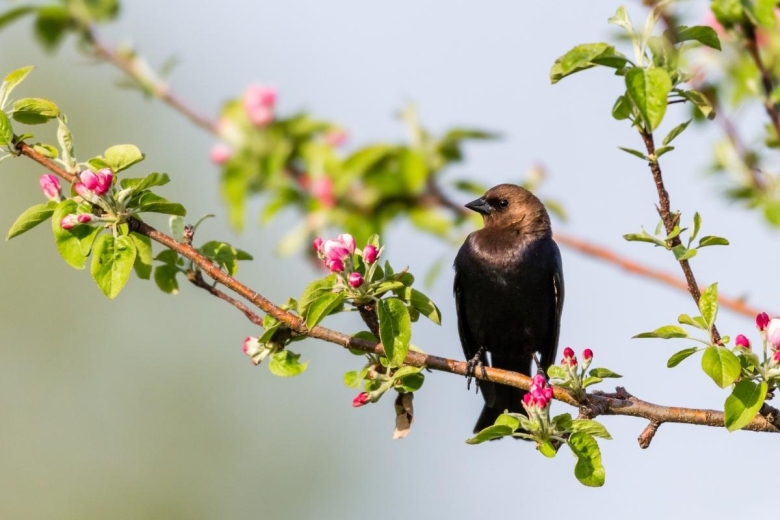
Brown-headed Cowbird is a common Georgia resident with some very questionable breeding behavior. They are smallish in appearance with a short, thick bill. The male is a glossy black with a brown head, while the female is brown all over. The male grows to 7.5 to 8.7 inches in length and weighs between 1.5 and 1.8 ounces with a wingspan of 14.2.
The female is slightly smaller. They can be spotted in fields, meadows, lawns, and pastures feeding on insects and seeds. They are breeding parasites, with the female laying her eggs in the nest of other birds and expecting another bird to hatch them.
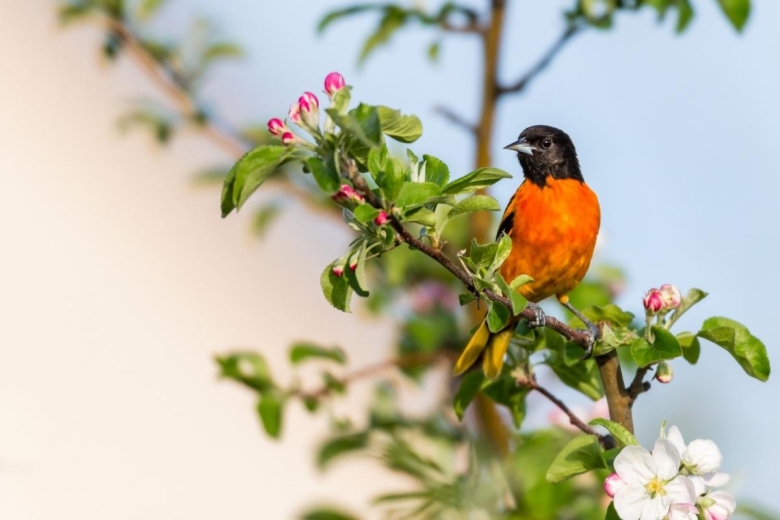
Baltimore Oriole arrives in Georgia in the spring from its winter migration. They are medium sized with a thick neck and long legs and pointed bills. The male is a bright orange with a black head and black wings with a white bar. The female is more yellow, gray on the head, and has two white wing bars.
Both grow 6.7 and 7.5 in length and weigh 1.1 to 1.4 ounces with a wingspan between 9.1 and 11.8 inches. They inhabit the top of deciduous trees in open woodland, orchards, parks, and backyards, where they feed on insects and berries. They are also very fond of nectar and sugar water.
Black Birds in Georgia
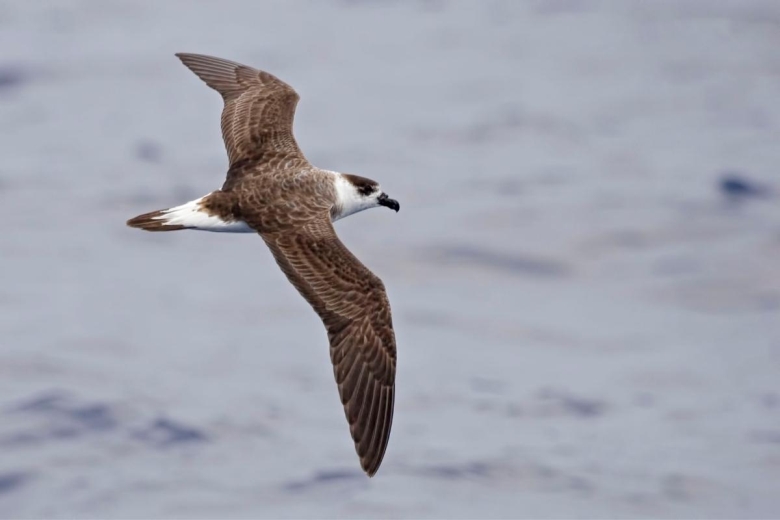
Black-capped Petrel can be found over the waters of Georgia as it dives for fish. They are medium sized with a dark back and long, dark wings and a white nape and rump with a white underbelly. They are named after the black cap on its head. They also have a long neck and long, thick legs and a pointed bill. The Black-capped Petrel grows to a length of 16 inches with a wingspan of 37 inch.
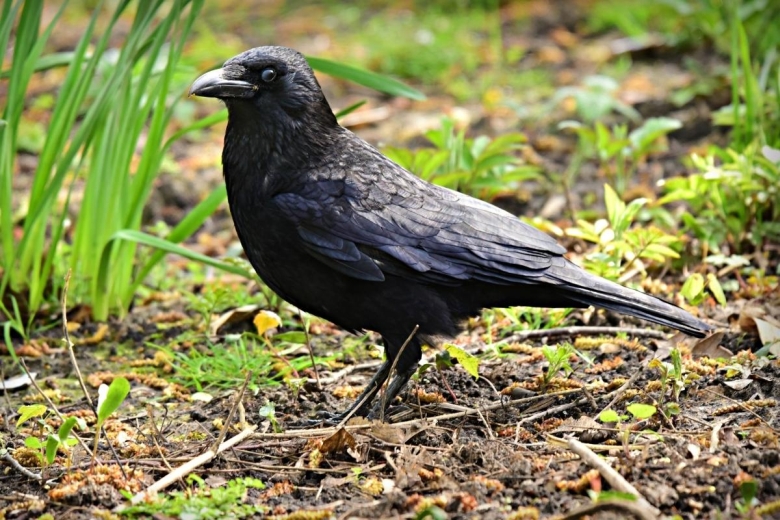
Black Crow is a common sight in Georgia. It is long-legged with a thick neck and a short tail and is entirely black – from bill to legs. They grow 15.8 to 20.9 inches in length and weigh 11.2 to 21.9 inches with a wingspan of 33.5 tom 39.4. They can easily be spotted over open fields and forests, but they also enjoy being near people, such as in parking lots, and city garbage dumps, which is convenient because they will eat almost anything.
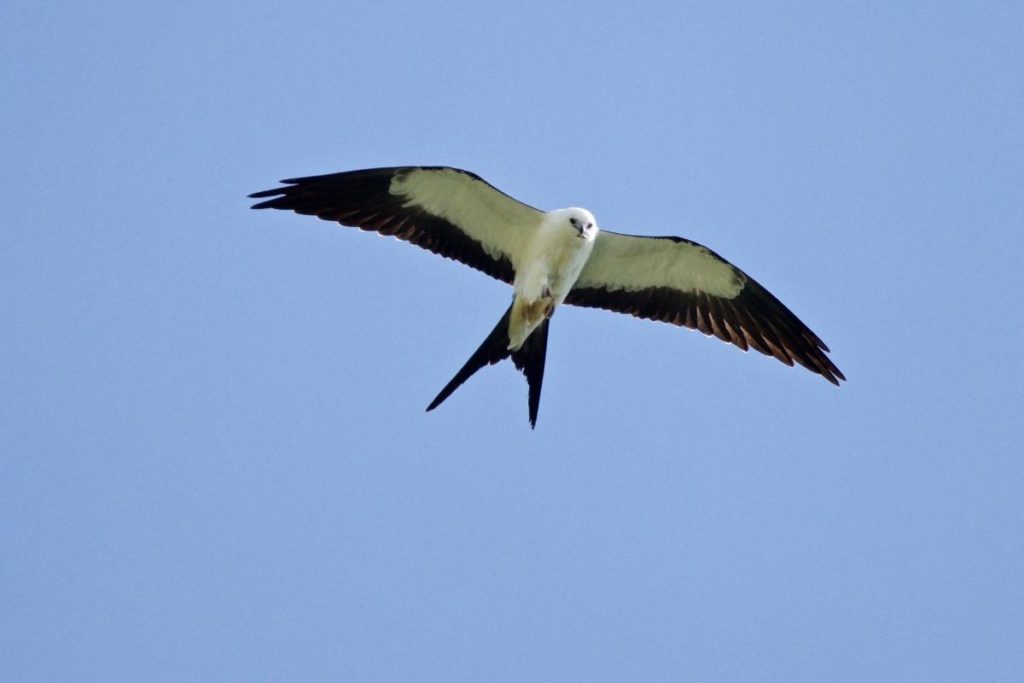
Swallow-tailed Kite can be spotted in Georgia during the spring and summer. They have long wings and a long, forked tail. They are dramatically black and white, with a white head and belly and black wings with white lining, along with a black back and tail. They grow 19.7 to 25.2 inches in length and weigh 13.1 to 21.2 ounces with a wingspan of 48.0. They spend a great deal of time flying and searching for prey in trees.
Blue Birds in Georgia
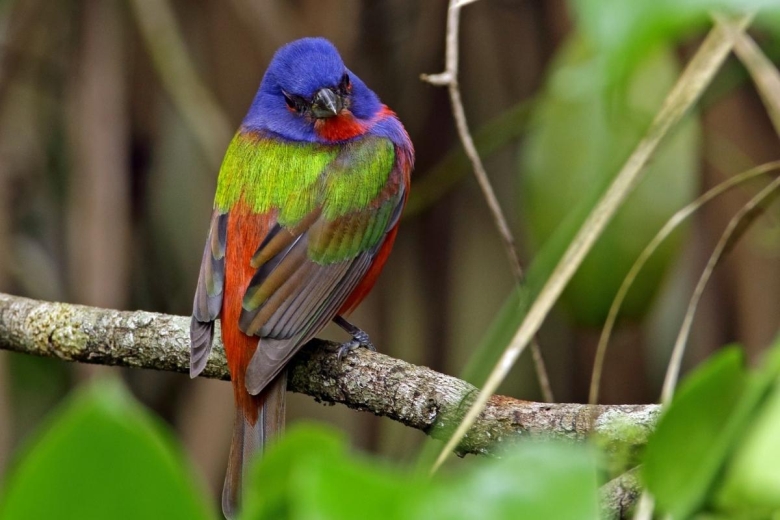
Painted Bunting can be spotted on the many Georgia sea islands. The males are a masterpiece of color with a blue head, red underbelly, and green backs. The female is a duller yellow green. They grow 4.7 to 5.5 inches in length and weigh 0.46 to 0.67 ounces with a wingspan of 8.3 to 9.1 inches. They can be seen in woodland, roadsides, and garden as they feed on seed, insects, and seeds.
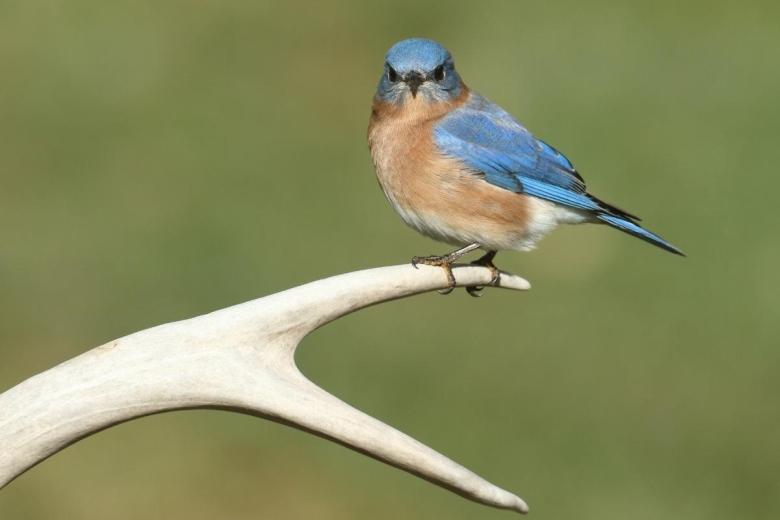
Eastern Bluebird in Georgia can be found during the winter in parks, golf courses, woodlands, and cemeteries. They are a small bird with a plump body and a large head and short legs and tail. The male is a bright blue with a rust patch on the throat while the female is a plainer shade of gray with some lighter blue in the wings and a lighter shade of rust on the throat.
They grow 6.3 to 8.3 inches in length and weigh 1.0 to 1.1 ounces with a wingspan between 9.8 and 12.6 inches. These birds inhabit meadows, golf courses, fields, and open areas and enjoy insects and berries.
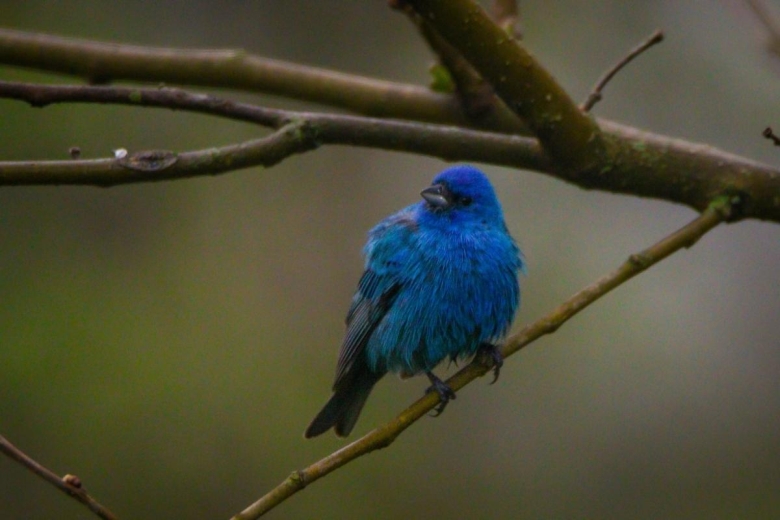
Indigo Bunting can be found in Georgia’s fields, forest clearings, and brushy areas where they feed on insects, seeds, and berries. The breeding male is a dazzling blue with a silver-gray bill. The female has light streaks on her breasts and some faint blue on the wings. Both sexes grow between 4.7 and 5.1 0.4 to 0.6 in length and weigh 0.4 to 0.6 ounces with a wingspan between 7.5 to 8.7.
Red Birds in Georgia
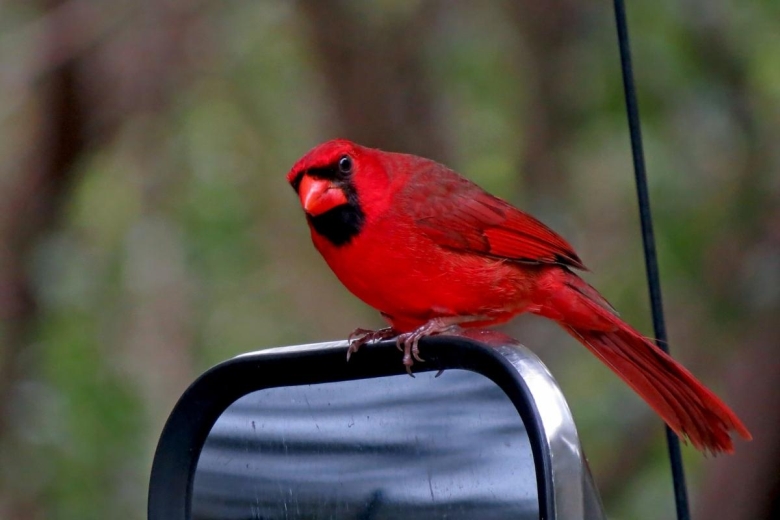
Red Cardinal is Georgia’s most-spotted bird. This breathtaking beauty has a long tail, a fat bill, and a jaunty, devil-may-care crest. The male is vividly red, including its bill, with black around the eyes and throat. The female is a pale brown with mere hints of red. She does have the same black face markings.
Both sexes grow between 8.3 to 9.1 inches in length and weigh 1.5 to 1.7 inches with a wingspan between 9.8 to 12.2 inches. They spend their time in shrubs or low to the ground foraging for insects, seeds, weeds, grain, berries, and fruits.

Purple Finch is in Georgia from October through May. They are large with a fierce conical beak and have a delicate red shading on the breast and head with a pale belly. The female has browning streaks throughout.
Both grow between 4.7 and 6.3 inches in length, weigh 0.6 and 1.1 ounces with a wingspan between 8.7 and10.2 inches. The Purple Finch likes forests, coniferous or deciduous and feeds mostly on seeds – especially seeds from trees – and insects and berries.
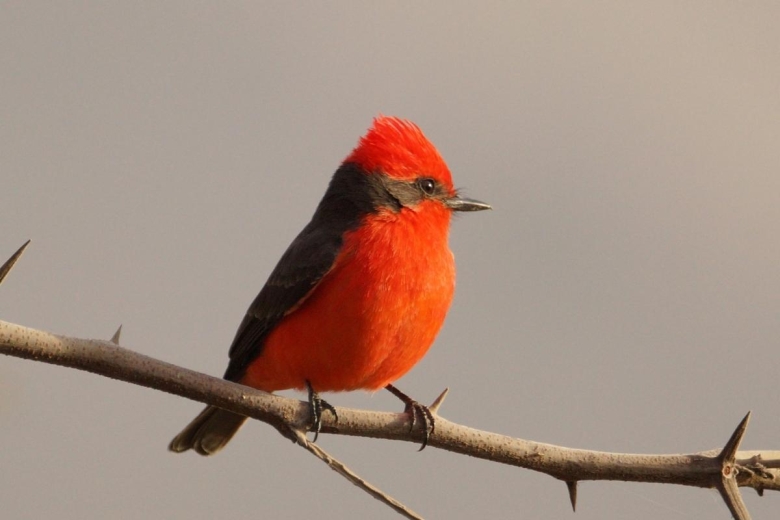
Vermilion Flycatcher has been spotted in the southern part of Georgia during the winter. The male is a reddish orange with a brown mask and brown back, wings, and tail. The female has gray-brown streaks down her breast with a blush on the underbelly.
They are small, growing 5.1 to 5.5 inches in length and weighing 0.39 and 0.49 ounces with a wingspan between 9.4 to 9.8 inches. The Vermilion Flycatcher inhabits scrublands, farmlands, and parks – anywhere they can find willow, sycamore, or cottonwood trees. They feed on flying insects.
Orange Birds in Georgia

American Robin migrates through Georgia in the winter. It is a large bird with long legs and a long tail and gray-brown feathers, a black head, and an orange underbelly. The female has a lighter head. Both the male and female have white spots around the eyes.
Both sexes growth between 7.9 to 11.0 inches in length and weigh 2.7 to 3.0 ounces with a wingspan between 12.2 and 15.8 inches. They inhabit parks golf courses, fields, as well as pine forests and deciduous woodlands. Their diet does not include seeds; instead, they feed on insects, worms, and fruits.
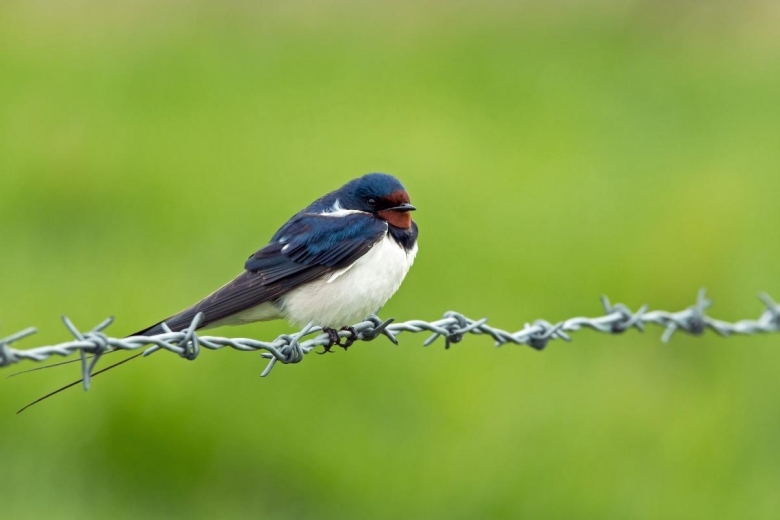
Barn Swallow can be seen in southwest Georgia sitting on fences or electrical wires. It has broad shoulders and long wings with a long, forked tail. The back, wings, tail, and top of head are a bright blue, while the face is a bright orange and the underbelly a more sedate shade of orange.
Both sexes grow 5.9 to 7.5 inches in length and weigh 0.6 to 0.7 ounces with a wingspan between 11.4 and 12.6 inches. They can be seen in many places, from parks, fields, marshes, meadows, and coastal waters. Usually, they will nest inside barns or bridges. They feed on insects.
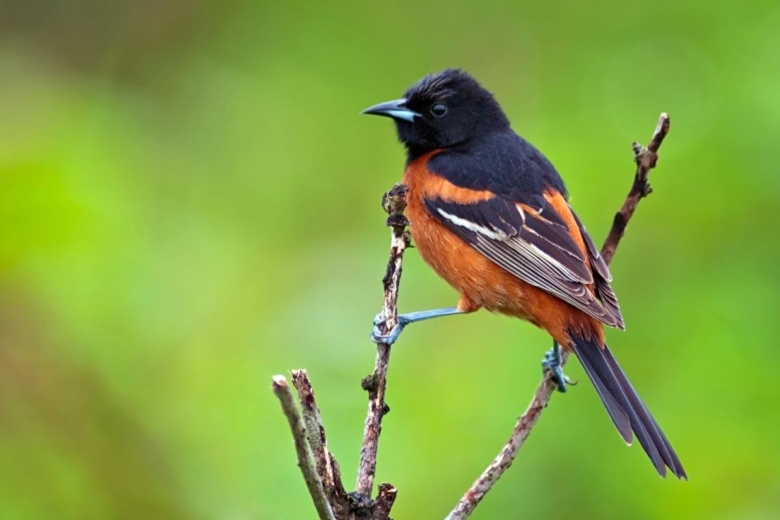
Orchard Oriole arrives in Georgia each spring. This medium-sized bird has a very sharp bill. The male has a black head, throat, tail and wings with an orange underbelly. The female is a yellowish green and has two white wing bars.
Both sexes growth to 5.9 to7.1 inches in length and weigh 06 to 1.0 ounces with a wingspan of 9.8 inches. They spend their time in open woodlands, parks, and orchards and forage for insects, berries, and fruits – they apparently color-coordinate their appearance to one of their favorite meals – orange slices.
Yellow Birds in Georgia

Cedar Waxwing is seen in Georgia during the months of November to May, although a few remain for the entire year. It is a medium-sized bird with broad wings and a short tail. Both sexes grow between 5.5 and 6.7 inches in length and weigh 1.1 ounce with a wingspan between 8.7 and 11.8 inches.
They have a light brown coloring on the head and chest and gray wings with red tips. The underbelly is yellow, and the long wings are gray with a yellow tip. Its most noticeable feature may be the black eye mask lined in white, making it look like a chic robber about to take flight. The Cedar Waxwing inhabits woodlands, farms, and orchards – anywhere it can find fruits.
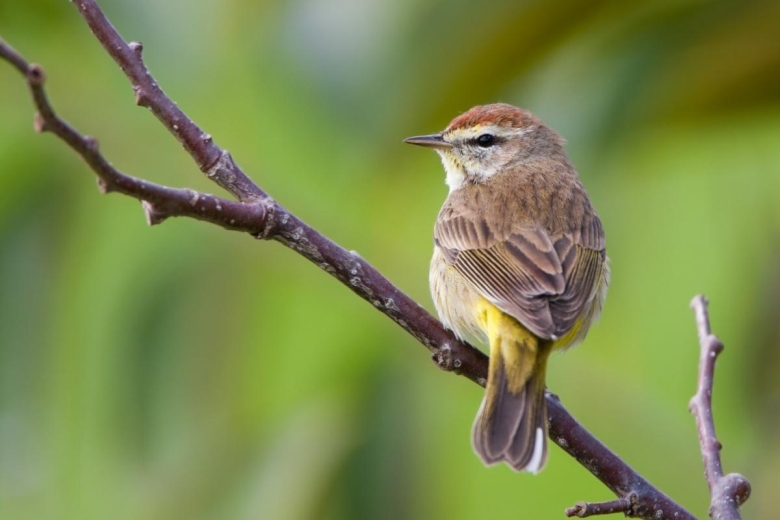
Palm Warbler migrates through Georgia from April and October but can also be seen in December. Their wings are a light brown, and their underbelly is a striped yellow. Both male and female have a rusty cap on their head. While they can be identified by their looks, their incessant tail-wagging also gives them away.
They grow 4.7 to 5.5 inches in length and weigh between 0.3 to 0.5 ounces with a wingspan between 7.9 and 8.3 inches. They spend time in areas with scattered trees and forage for insects on the ground.
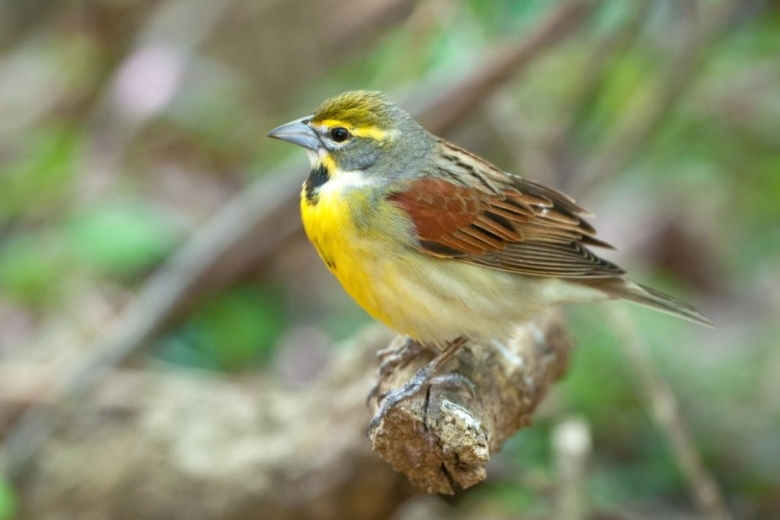
Dickcissel can be spotted in Georgia’s Piedmont region. The male has a gray head with a bright yellow face, a short, bold beak, and a yellow chest with a large black V mark, which the female does not have. The wings and tail are shades of brown streaks. Both the male and the female have yellow-rimmed eyes.
They grow between 5.5 to 6.3 inches in length and weigh 0.9 and 1.4 ounces with a wingspan between 9.8 and 10.2 inches. The Dickcissels can be found in grassland, pastures, and prairies, where they forage for insects, seeds, and crops such as rice and sorghum.
Common Birds of Georgia by Species
Hummingbirds of Georgia

Ruby-throated Hummingbird – Archilochus colubris – is the only Georgia Hummingbird to actually nest in the state before migrating for the winter. This hummingbird is small with a long, slender bill. It is bright green on the back, with a grayish underbelly and a bright red throat.
The Ruby-throated Hummingbird grows 2.8 to 3.5 inches in length and weighs 0.1 to 0.2 ounces with a wingspan between 3.1 and 4.3 inches. They can be found in open areas such as meadows, parks, grasslands, and gardens, where they feed on nectar and insectes. They will visit a bird feeder for sugar water.
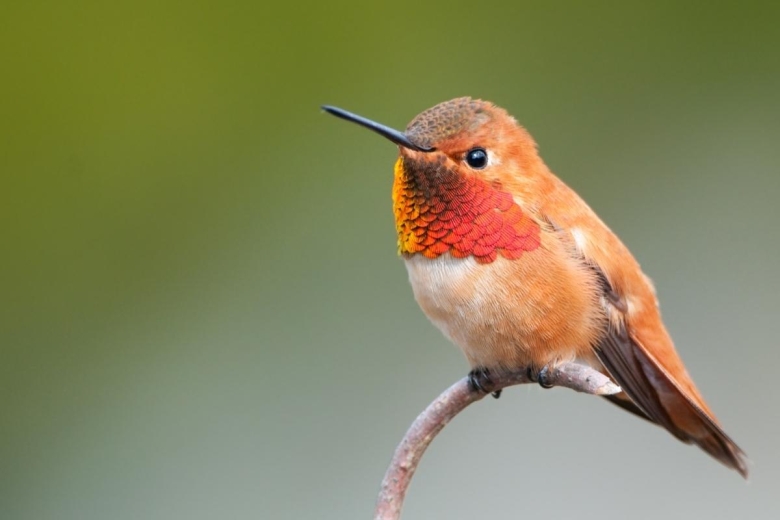
Rufous Hummingbird – Selasphorus rufus – can be spotted in Georgia during the winter. The male is a bright orange on the back and wings with a bright red throat which actually glows in the right light. The female is gray-green with a white underbelly. Both sexes grow to 2.8 and 3.5 inches in length and weigh 0.1 to 0.2 ounces with a wingspan of 4.3 inches. The Rufous Hummingbirds can be found in yards and parks with nectar-rich blooms where they enjoy nectar and insects.
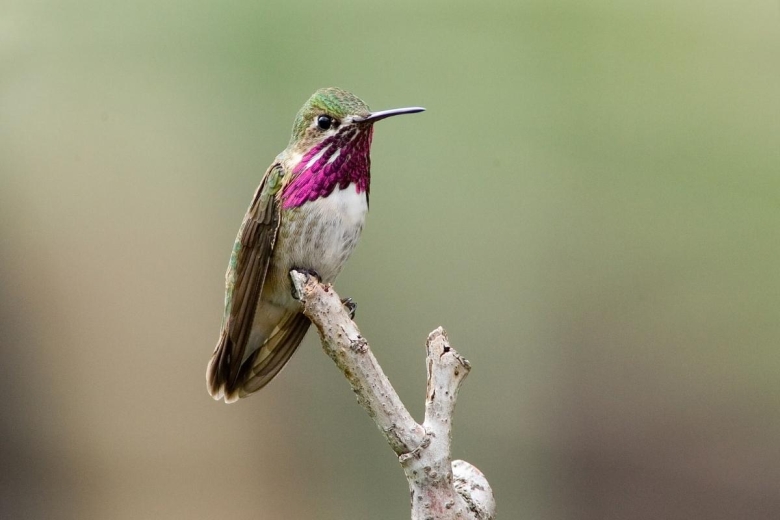
Calliope Hummingbird – Selasphorus calliopeis a resident of Georgia during the winter months. It is one of the smallest Hummingbirds with a short tail and wings. Even its bill is short. The most notable feature of the male Calliope Hummingbird is the vivid magenta stripes on the throat.
Male and female are green above, but the male also has some green below, while the female’s underside is a pale peach. Both sexes grow to 3.1 to 3.5 inches in length and weigh 0.1 ounces with a wingspan between 4.1 to 4.3 inches. They inhabit forests and meadows and, like most Hummingbirds, enjoy insects and nectar.
Finches in Georgia

House Finch – Haemorhous mexicanus – can be seen year-round in Georgia. They are small with sizeable beaks and a long tail. The male has a rosy-red head and upper chest and brown streaks down the back, front, and tail. There is a red rump that isn’t always conspicuous.
The female is grayish brown streaked all over. Both sexes grow 5.1 to 5.5 inches in length and weigh 0.6 to 0.9 ounces with a wingspan between 7.9 to 9.8 inches. They enjoy perching on trees and munching on seeds.

Purple Finch – Haemorhous purpureus – is in Georgia during October and May. They are chunky with powerful beaks and a short tail. They are a beautiful pink around the head and breast with a brown back and white belly. The female has brown streaks on the top and bottom with the wings being a darker streaked brown.
She also has white lines around the eyes. Both sexes grow 4.7 to 6.3 inches in length and weigh 0.6 to 1.1 ounces with a wingspan between 8.7 to 10.2 inches. Their live high up in forest canopies and can be difficult to spot. They feed on seeds and can be lured to bird feeders with sunflower seeds.

Evening Grosbeak – Coccothraustes vespertinus – inhabits northern Georgia’s coniferous forests during the winter. They are large, heavyset finches with very thick, powerful, conical bills. They have a thick neck, full chest, and relatively short tail. The male is yellow and black and has a yellow stripe over the eyes, a black tail, and white patches on the wings.
The female is a dull gray with black and white wings. Both sexes grow 6.3 to 7.1 inches in length and weigh 1.9 to 2.6 ounces with a wingspan between 11.8 and 14.2 inches. They inhabit tree canopies and fores for insect larvae, seeds, berries and fruits.
Shorebirds in Georgia

American Avocet – Recurvirostra americana – inhabits the coast of Georgia and is a slender, long-legged shorebird with a long neck and bill. Breeding adults have a light rusty head, neck and chest that turns gray after the breeding season. Both males and females have black patches on white wings.
Their long legs are gray. Both sexes grow 16.9 inches to 18.5 inches in length and weigh 9.7 to 12.3 ounces with a wingspan of 28.4 inches. They wade through the shallow waters of the shore and sweep their bill from side to side in an effort to catch aquatic invertebrates.
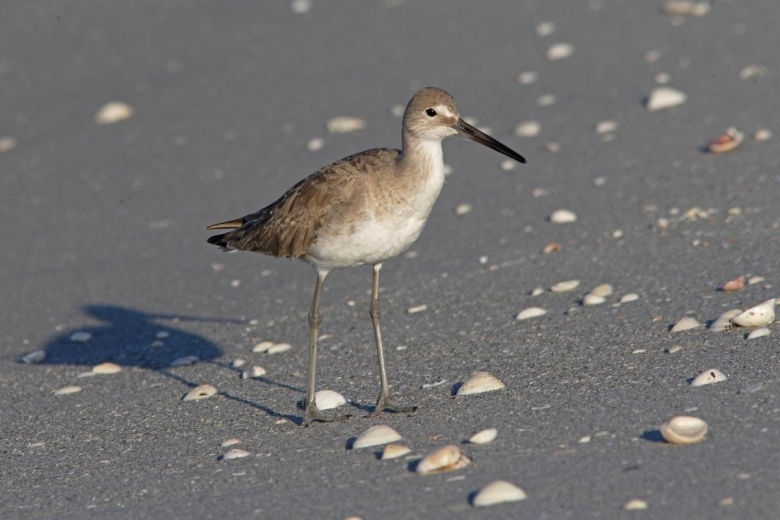
Willet – Tringa semipalmata – is one of the few shorebirds that actually nests in Georgia, but away from the shore – they build their nests in grassland near freshwater. They are stocky with long legs and a thick, straight bill. During the summer, they are a mottled gray brown all over, while in the winter they turn a simpler gray.
Their legs are a blue-gray. Both sexes grow 13.0 to 16.1 inches in length and weigh 7.0 to 11.6 ounces with a wingspan of 27.6 inches. They saunter through mud and sand in search of worms, crabs, insects, and mollusks,
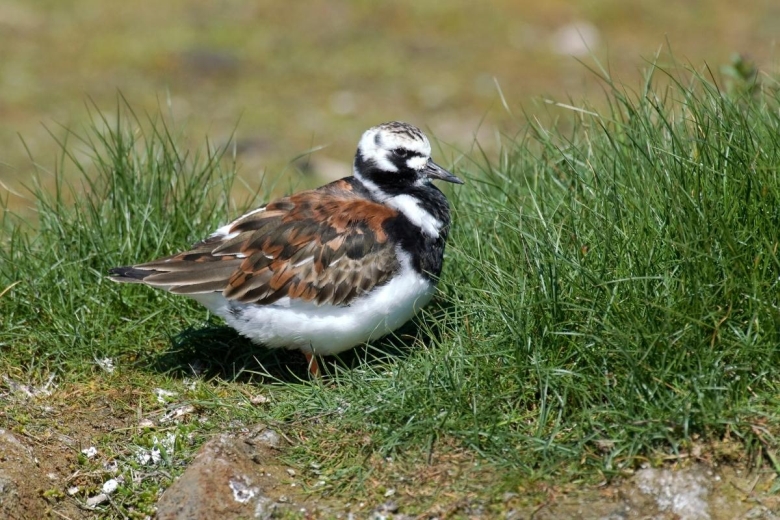
Ruddy Turnstone – Arenaria interpres – spends the winter by Georgia’s coast, near the south end of Tybee Island. They are stocky and short and, unusual for shorebirds, they have short legs. The male has black and white face markings on the head and throat and a motley brown and black design on the back with brown and white streaked wings.
The female is a bit paler. Both have a pale underbelly and orange legs. They grow 6.3 to 8.3 inches in length and weigh 3.0 to 6.7 ounces with a wingspan between 19.7 and 22.4 inches. They spend little time in the water, preferring to forage through rocks and seaweed along the shore in search of crustaceans, mollusks, insects, seeds, and berries. When not breeding, they feed on crabs, sea urchins, and small fish.
Further Reading on Georgia Birding
For more information on birding in Georgia, consider the following guidebooks:
Visit these sites for additional information:


